Lora Langston's Blog
October 30, 2022
Color Wheel Ideas Creative Intro 2D Art Rainbows
Let's face it, kids don't want to paint a boring color wheel. Change up your color wheel lesson for your intro or homeschool art class with these creative ideas for a color wheel! It's still a basic rainbow color wheel, but when you let students add their own flair, it becomes an art project that they are happy to display.
This post contains Amazon and other affiliate links.
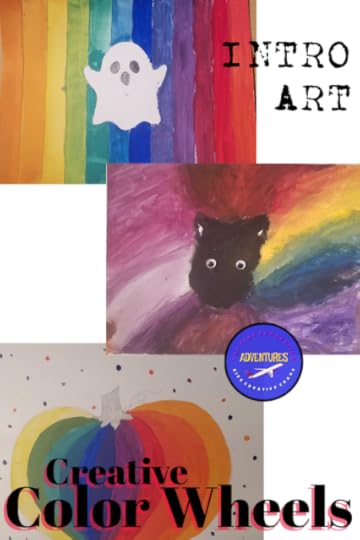
Simply show the students a basic color wheel or grab some prisms to teach the color order of the rainbow and let their imaginations run wild! You can use markers, tempera paint, or water colors. Water colors tend to blend easier for a gradual, visual color change. Use tempera for an exact mixing of primary, secondary, and tertiary colors. There's more to color than ROY G. BIV.
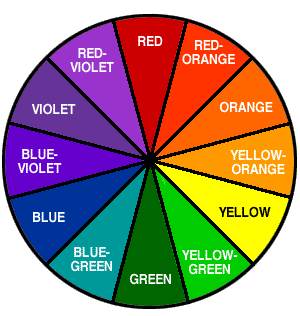
What order do the colors go on the wheel? It depends where you start. Think about a rainbow or use a prism to display the colors in their natural light spectrum order. Allow students to paint anything they want as long as they demonstrate an understanding of the rainbow color wheel order.
Rainbow Activities
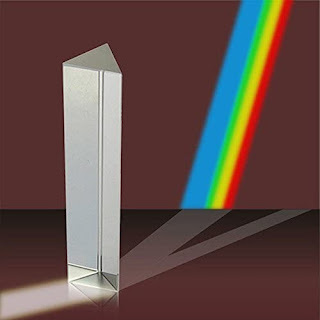
Use Prisms to show the rainbow of light spectrum colors.
How to Make a Creative Color Wheel
Color Wheel Project Supplies Needed:
Mixed Media PaperBasic Water Color Paint KitBrushesEgg Carton for Mixing and RinsingTable Cloth - Use kraft paper rolls like the ones pictured below.
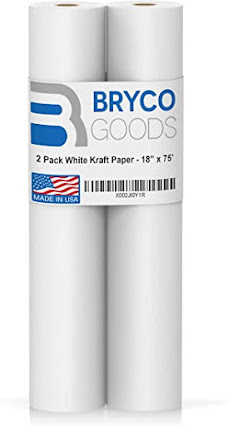
You can find more ideas for a preschool or early elementary basic color wheels on our site. We also have a cool, color theory paper project with detailed information on the various color schemes.
Classroom Skit about a Rainbow
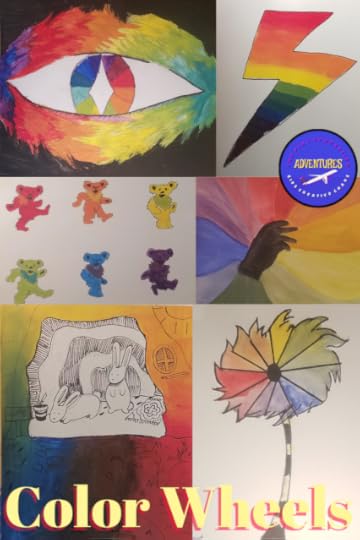
Recommended:
3 Rainbow Cake Decorating Ideas
How to Make Rainbow Drink Coasters with Pony Beads
Rainbow Fish Construction Paper Art Project for Kids
Recipe: How to Make Rainbow Graham Cracker Sandwiches
October 13, 2022
Painting with Scissors Simple Cut Outs Matisse Abstract Art Project
Henri Matisse was best known as an abstract artist. He aligned himself with a small group of artists known as Fauvists or Wild Beasts. Unlike other painters during this era, he painted with bold colors and took risks with his art. Matisse called his cut paper art posters, painting and drawing with scissors So, how do you paint like Henri Matisse? With paper cut-outs, of course.
This post contains Amazon and other affiliate links for your convenience.
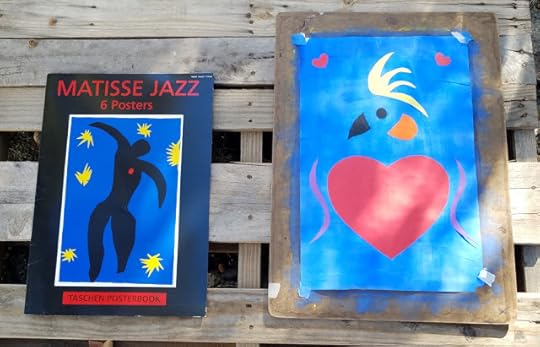
The Cut Outs or Painting with Paper are part of the Matisse Jazz Series. Matisse created a few artists’ books, many were made in 1941 after he suffered with intestinal cancer. With this technique, he was able to stay in bed and still create art.
Henri Matisse Paper Cut Outs Video for Students.
The painting of the figure with stars around it is one of the most well-known in his Jazz series. The book is made up of circus and theater theme posters made with cut and pasted brightly colored papers that are printed using a stencil technique known as pochoir. Most of the images in the Jazz series are done in primary colors.
You may have seen a similar cut paper technique in a series of children's books painted and illustrated by Eric Carle. Carle was influenced by the works of Matisse and other abstract artists. Here's an art lesson on Eric Carle. You can also experiment with Eric Carle's technique of wet paper illustration with this lesson, how to paint like Eric Carle.
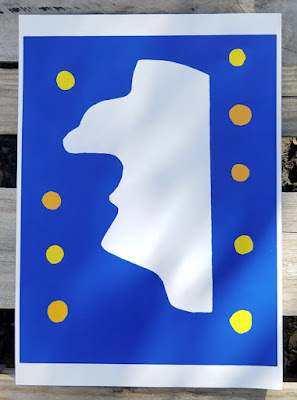
With his cut paper art, Matisse invented a new form of art, the cut-out. He called this new art form drawing with scissors. He cut out various geometric and organic shapes and arranged them on his gouache painted canvas to illustrate his books. He also hand wrote about each image in cursive rather than using a type setting. This style is similar to today's scrap booking. You can create your own book that has meaning to your life with this simple, inspired by Matisse, technique.
Paint Like Matisse
Supplies Needed:
Mixed Media Paper,18 x 24"Tempera or Acrylic Paint in primary colorsWide Paint BrushBrightly Colored Copy PaperGlue StickSubject Matter that is Meaningful
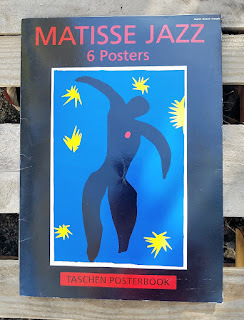
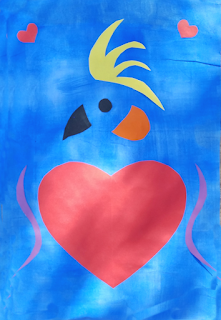
We decided to take inspiration from the Jazz poster's cover painting. Using the same primary color scheme, we added secondary colors in orange and violet. There are not lines or any drawing on the art work; everything is done in paper cut outs. Remember, it is abstract art! Use shapes and meaningful colors to represent your subject matter. Our paper painting represents a family pet. Our Cockatiel, Nebu, died at the age of twenty-three. Squinting your eyes while looking at a cockatiel will allow you to see his basic features, yellow spiked crest and orange cheek. The heart represents how close he was to our hearts, and the violet squiggles represent his wings in motion. They can also represent a flutter or the beating of his heart.
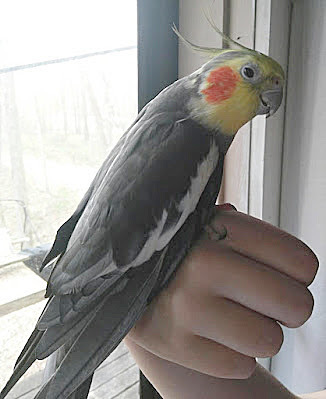
While you're planning your design think about the Elements of Art and the Principles of Design. How many can you use? Ours has color, line, shape, space, balance, movement, contrast, emphasis, and harmony. Do you see more? In the comments below, tell us what you see.
MATISSE ABSTRACT ART LESSON PLANPainting with Scissors and Paper Cut Outs: How to Paint Like Henri MatisseStep one: Come up with a subject matter that means something to you.Step two: Sketch it out in your sketch book.Step three: Think about it in an abstract way.Step four: Do a thumbnail sketch changing your drawing into basic shapes.Step five: Paint your paper background in a primary color or black.Step six: Cut out your shapes.Step seven: Arrange your shapes on the paper. Think about the Principles of Design, especially balance and unity. Shapes should be abstract, and it shouldn't be immediately obvious what the picture represents (not realistic.) See our student examples below. No drawing! Remember, you are painting with paper.Step eight: Paste them into position. Tip: Do not use school glue, it bubbles up. Glue sticks work best.Step nine: That's it! It's that simple to paint like Henri Matisse!
These are student examples from the NCHS Intro to 2D Art class. You may not use these images or reproduce them anywhere else. They are for educational purposes only.
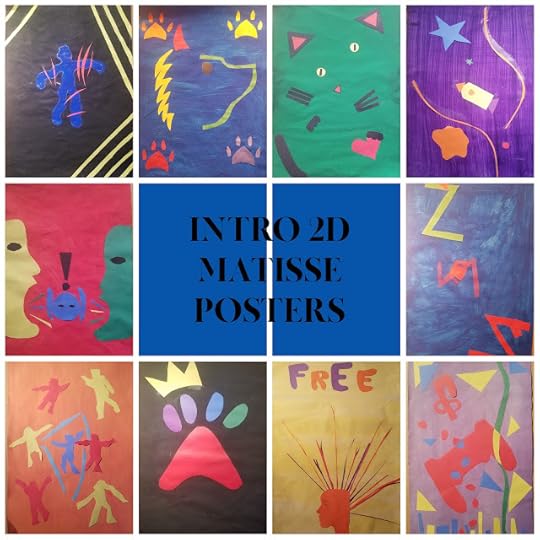
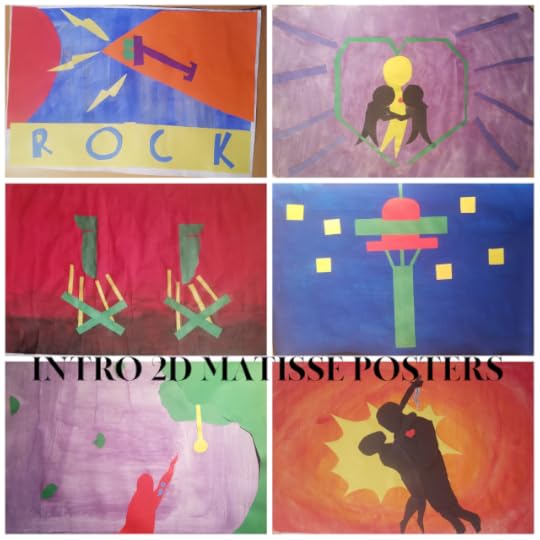
If you want to try this project with preschoolers or elementary students, you may also like to add some books to your Matisse art lesson plans. The books below make excellent companion books for a lesson on Henri Matisse's painting with scissors abstract poster series. Don't forget to read your students some Eric Carle books and remind them that he was influenced by Matisse.
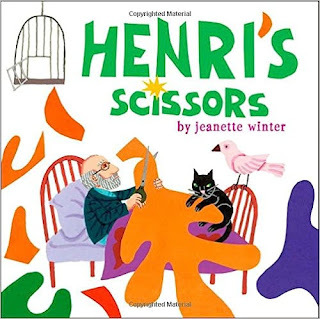
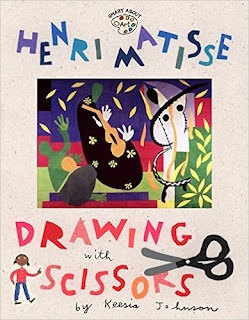
Recommended Reading:
Henri's Scissors Children's Book Drawing With ScissorsRehoming Pets After a move
September 20, 2022
COBRA KAI LEGEND TEE INSPIRED LETTER COLOR SCHEME ART PROJECT
If you watch the popular NETFLIX series, Cobra Kai, you've probably noticed the t-shirts worn by the Anthony LaRusso character, played by Griffin Santopietro. In the series, Anthony is the son of Daniel and Amanda LaRusso, and the younger brother of Samantha LaRusso. He often wears cool printed tees, below the word LEGEND is printed in two tone letters across his shirt. The colorful block print letters inspired this letter color scheme art project perfect for a quick lesson on color theory.
This post contains Amazon and other affiliate links for your convenience.
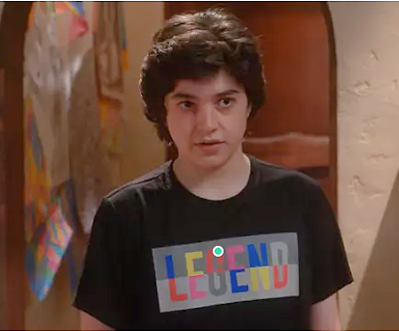 Letter Art Project: Anthony LaRusso Legend Tee in Cobra Kai
Letter Art Project: Anthony LaRusso Legend Tee in Cobra KaiIn my high school art class, we've been working on several projects with a letter theme. We started creating tag letters for a graffiti art project and then we moved on to a lesson color theory and how to blend with colored pencils from That Art Teacher. To review the basics of color theory or to achieve a better understanding of the color wheel, watch this video, Color Theory Basics or scroll down to read our simple definitions.
The video below is an awesome companion video to use when teaching the history of graffiti art.
LEGEND Color Theory Letter Project
This letter color scheme project can be be simple or more complicated and adapted for all grade levels. For a simple project for elementary students, simply cut and paste the letters onto a 6" x 12" white, gray, or black poster board using contrasting colors from the basic color wheel. For our homeschool friends that means: Red/Green, Blue/Orange, and Purple/Yellow. Remind your students to eyeball the letters and center the word on the page before the final glue down.
You might also like: How to Paint like Eric Carle
For high school students in a basic art class, remind the students that contrasting colors are simply colors that are opposite each other on the color wheel. This will give more color options. For more advanced classes, have art students design their letters based on a color scheme: monochromatic, complementary, double complementary, split complementary, triadic, tetradic, analagous, intermediate primary, secondary, or tertiary. We used cut, brightly colored paper in anticipation of a color paper unit on Matisse, but you can also use acrylic paints.
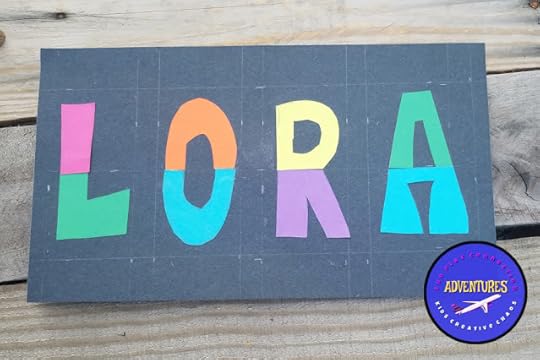
What are the Color Schemes?Monochromatic - One color. A monochromatic color scheme ranges between lighter (tints) and darker (shades) versions of the base color or hue.
Primary - The basic colors. Red, Yellow, and Blue. With crayons, pencils, and paint, these colors can be combined to create the secondary colors. (Don't let Google and Digital Art confuse you.)
Secondary - Green, Orange, and Purple. (Red + Blue) = Purple, (Red + Yellow) = Orange, (Yellow + Blue) = Green.
Triadic - Primary and secondary color schemes are also triadic colors schemes. A triadic color scheme is made up of three colors evenly spaced on the color wheel. These colors form a triangle across the color wheel.
Tertiary - A primary color + a secondary color. Tertiary colors combine primary and secondary colors to create compound colors: blue-green, blue-violet, red-orange, red-violet, yellow-orange, and yellow-green.
Complementary - Two colors that are on opposite sides of the color wheel. The basics are Red/Green, Blue/Orange, and Purple/Yellow. However, you can pull-out a color wheel to find more variations such as, Yellow-Orange/Blue Violet.
Double Complementary or Tetradic - Using two sets of Complementary colors together. For example, red/green paired with yellow/purple. A double complementary color scheme forms a rectangle across the color wheel.
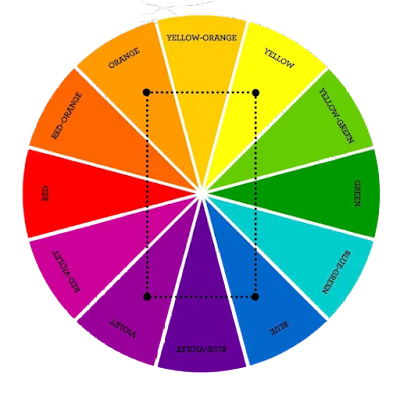
Split Complementary - A split complementary scheme uses three colors. Start with one color, find its complement and then use the two colors on either side of it. If you look at the color wheel above, blue, violet (purple,) and yellow-orange form a split complementary triangle. Yellow-Orange/Blue-Violet being the contrasting colors and blue and violet are the splits. If using Blue-Violet, the split complementary colors are Orange and Yellow. Get it? Got it. Good!
Analogous - Analogous colors are next to each other on the color wheel. Only use three to five colors for this color scheme. Analogous schemes can use warm colors, cool colors, or a combination of both depending on where you start. For art that pops stick to three analogous colors.
Intermediate - The tertiary colors are every other color on the color wheel. Tertiary colors combine primary and secondary colors to create compound colors: blue-green, blue-violet, red-orange, red-violet, yellow-orange, and yellow-green. This is also known as an intermediate color scheme.
For printable lessons, visit me on TeachersPayTeachers
How to Make Block Color Scheme LEGEND Letters with Bright Colored Paper
Supplies:
Black, White, or Gray Poster Board (6" x 12")RulerPencil Scissors or Xacto KnifeBrightly Colored Copy Paper or Construction Paper
Beginners will want to measure to choose letter size and then eyeball the position on the poster board before gluing it down. Divide 12" by the number of letters you choose to use. The answer will provide enough space for your letter and the space between each letter. For example, 12/6 = 2". Allow 1 1/2" for each letter and use the extra space to form a border and proper letter spacing.
More advanced students should use the ruler to lay out a grid on the poster board. Draw separate grid lines for the block letter, space between the letters, and a border around them. Showing the students how to layout and plan for the block letter spacing will prepare them for future work in sign painting, drafting, technical theatre, and architecture.
Draw a horizon line halfway down the middle of the paper at 3". This line serves as the dividing line for the color of the letters. Each letter will be two colors based on one of the color schemes listed above. for younger students, choose contrasting colors. Measure for at least a 1/4" border from the edges of the paper. The width of letters is determined by the number of letters used as mentioned above. If you cut the letters out from a block of paper, with an Xacto knife, you can use the paper as a template to paint letters for a future project.
Recommended:
Primary Color Lesson for Preschool or Early Elementary
Cobra Kai Tees
Homeschool Art and Craft Projects
September 13, 2022
How to get Baby to Sleep for a Nap
Are you struggling to get your little toddler to take a breather and rest? Nap time can be heaven for both you and your toddler. They get some much-needed rest before carrying on with their day, giving you a chance to get a few things done, or simply take a minute for yourself. You've probably wondered, how to get your baby to sleep for a nap, here are some tips to earn that well deserved quiet time.

While nap time sounds like a dream, getting your toddler down and asleep is much easier said than done. Although some days may not run to plan, there are some great ways to encourage a toddler to take his nap, so you can have a moment to get through your to-do list. Here are some infant nap time parenting tips so you can get some things done around the house.
Encourage or play active games with them
Active games are a great way to burn off all that extra energy before a nap. It can be as simple as a game of Simon Says or Head, Shoulders, Knees and Toes. Not only are these games fun and easy, but they also require minimal set-up and clean up.
Simon Says can help kids learn about body awareness and movement, as well as how to pay attention, follow instructions and be a leader. Whereas Heads, Shoulders, Knees and Toes can help kids with their balance, coordination and learning about their bodies.
Other games like Duck Duck Goose and Ring Around the Rosie lets kids literally run around, but can also help them develop strategic thinking skills and spatial awareness – although you’ll need more than one child (or adult!) to be able to play them.
Get some fresh air and/or exercise
This goes without saying – exercise is a great way to tire your little ones. Ideally, any exercise you choose to do should burn through their excess energy without giving them a second wind and keeping them wide awake. The key is to stay active and keep babies moving, but not to have too much fun so they won't fight sleep when it comes.
The old stand by activities are great for tiring out your baby for outside play:
Bouncing or kicking a ball.
Riding a bike or scooter.
Playing chase.
Blowing bubbles.
You can even go for a light walk around the block or to their favorite playground. Let them loose on the play equipment and they’ll be ready to nap when they get home.
If the weather isn’t the best, you can still get your toddler moving at home. Encourage them to have a dance along to a music video or get them running and climbing with a make-shift obstacle course.
Put them to work with some household chores
If you’ve got a few jobs to get done around the house, why not get your toddler involved? This will take a little patience, the job will likely take a little longer, but every little chore will get your toddler closer to sleep.
The easiest way to make this nap time trick work is by giving your kids chores that are appropriate for their age, which also keep them active. Start with simple things like picking up their toys or tidying up their room. You can add a touch of fun to the household chores by having clean-up races, enjoying a toy scavenger hunt to be found in the bottom of the laundry pile, or making a game of loading the dishwasher.
Not only will doing household chores wear your kids out, it also teaches them responsibility about how a household functions. These are valuable life skills your children will carry with them throughout their lives. It’ll also help you get through the household chores on your to-do list, even if they’re not perfectly done!
Encourage winding down activities
Even with all their energy burnt off, your little one might not just drop straight off to bed. Sometimes they need a little quiet time to help them settle and wind down.
Relaxing activities that will keep their attention are key to quiet time. These activities can be as easy as giving them an age-appropriate puzzle, a simple coloring activity, or engaging them in quiet building activities, like a Lego set.
When all else fails, a good-old children’s book is a sure-fire way to help them unwind. You can encourage them to curl up on the couch and read to themselves or mimic bedtime and read to them as they fall asleep.
Create a nap time ritual
Complement winding down activities by creating a nap time ritual to follow. This should be similar to creating a bedtime ritual. It should be consistent, such as setting aside a specific period of time everyday for the nap, dimming the lights, reading a story to them, and playing some white noise (like rain or wind) to block out outside noises.
This nap time ritual gives your baby's body a cue to fall asleep, rest, and recharge.
Once you start giving these nap time sleep methods a try, you’ll soon be watching your little one drift off to sleep with ease, allowing you some much needed me time.
Recommended:
How to get Baby to Sleep through the Night Tips
June 17, 2022
3 Ways to Inspire Children
[[ This is a content summary only. Visit my website for full links, other content, and more! ]]
March 28, 2022
What are the Best Ideas to get Kids to Exercise
Nowadays, with all of the video games and gadgets available, it’s difficult to get kids to put away their screens and try something active. This...
[[ This is a content summary only. Visit my website for full links, other content, and more! ]]
March 26, 2022
How to Help Children Achieve Dreams and Goals
One of the main parts of being a parent is nurturing your child’s hobbies and aspirations. This way, they can make their dreams a reality. However, for...
[[ This is a content summary only. Visit my website for full links, other content, and more! ]]
March 25, 2022
Crafting Builds Confidence and Self Esteem in Children
Art and crafting activities have positive mental and physical benefits. Studies show that when children work together on craft...
[[ This is a content summary only. Visit my website for full links, other content, and more! ]]
Crafting Builds Confidence and Self Esteem in Childrren
Art and crafting activities have positive mental and physical benefits. Studies show that when children work together on craft...
[[ This is a content summary only. Visit my website for full links, other content, and more! ]]
March 1, 2022
Top Tips before Visiting a Waterpark in Australia
Summertime is the perfect time to head to the waterpark and enjoy some fun in the sun. With so many different waterparks located all around Australia, there's sure to...
[[ This is a content summary only. Visit my website for full links, other content, and more! ]]



